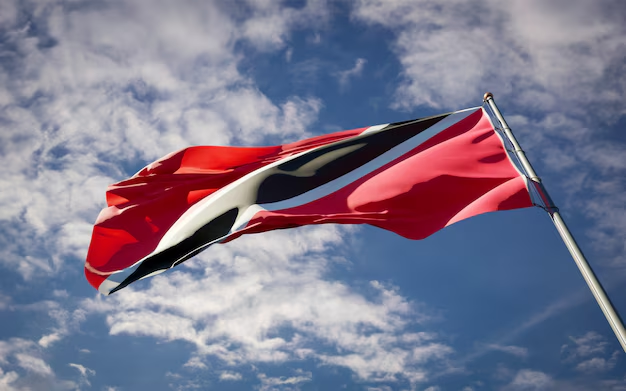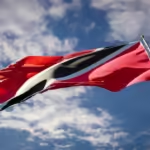The Trinidad flag is a vibrant symbol of the Caribbean nation’s rich history, cultural diversity, and independence. Known for its striking red, black, and white colors, the flag carries a deep sense of pride and significance. Whether you are interested in the history of Trinidad and Tobago, the symbolism of national flags, or learning about the nation’s cultural identity, understanding the Trinidad flag is a great place to begin.
In this article, we’ll explore the Trinidad flag in detail, covering its history, design, symbolism, and relevance today. We’ll also provide comparisons to other flags in the Caribbean and beyond to offer a broader context for its unique meaning.
The History of the Trinidad Flag
Pre-Independence Flags
Before Trinidad and Tobago gained independence in 1962, the island was under various colonial powers, which meant the flags flown were those of the European countries that governed it. For much of the 19th and early 20th centuries, Trinidad flew the British flag. This changed in 1958 when the Federation of the West Indies was formed, and a new flag was adopted, but it was still heavily influenced by the British colonial presence.
The Design of the Trinidad Flag (1962)
When Trinidad and Tobago gained independence on August 31, 1962, it needed a flag that would represent the sovereignty and identity of the nation. The Trinidad flag was designed by Carlton K. G. Johnson, a noted architect, and was officially adopted on August 31, 1962, the same day as the nation’s independence.
The flag’s design is straightforward but rich with meaning, reflecting the country’s cultural heritage and geographical features. The flag consists of three primary elements: colors, stripes, and a central emblem.
The Elements of the Trinidad Flag
The Colors
The Trinidad flag is composed of three colors: red, black, and white. Each color has its own significance.
- Red: The bold red color in the flag symbolizes the strength and vitality of the people of Trinidad and Tobago. It also represents the warmth of the nation’s hospitality and the energy of its people.
- Black: The black color stands for the resilience and the determination of the people, particularly their will to overcome challenges and thrive despite adversity. It also represents the nation’s rich African heritage, as both Trinidad and Tobago have strong African roots in their populations.
- White: The white color symbolizes peace, unity, and harmony. It reflects the country’s aspirations for peaceful coexistence among its diverse ethnic groups, such as Afro-Trinidadians, Indo-Trinidadians, and those of European and other ancestries.
The Design Layout
The Trinidad flag’s layout is simple but distinctive. The red background is divided by a black diagonal stripe that runs from the top left corner (hoist) to the bottom right corner. Within this black stripe is a white strip that creates a narrow separation from the red field. This geometric arrangement is both modern and bold, signifying progress, movement, and a bright future.
The Symbolism of the Diagonal Stripes
The two diagonal stripes are among the flag’s most iconic features. These lines are symbolic of the nation’s journey from colonization to independence, representing the paths that have converged to form the modern nation of Trinidad and Tobago. The black diagonal line represents the strength and unity of the people, while the white stripe symbolizes the nation’s dedication to peace and cooperation.
Trinidad Flag: A Symbol of Unity
Trinidad and Tobago is a multi-ethnic society, with significant populations of African, Indian, European, and indigenous descent. The Trinidad flag reflects this diversity, and each of its elements carries a deep connection to the people’s shared history.
For example, the red color on the flag represents the vitality and collective spirit of the nation’s people, whether of African, Indian, or European heritage. The black stripe, on the other hand, emphasizes the resilience and strength of the country’s multicultural society in overcoming centuries of slavery, indentured labor, and colonial rule. Finally, the white symbolizes the peace that Trinidad and Tobago strives for as a united nation despite its diverse cultures and traditions.
The Trinidad Flag’s Use in National and Cultural Celebrations
The Trinidad flag is prominently displayed during national celebrations, such as Independence Day on August 31, Republic Day on September 24, and Labour Day on June 19. Additionally, it is seen during sporting events, festivals like Carnival, and cultural gatherings that celebrate the nation’s history and achievements.
The Trinidad flag is also seen in the diaspora, particularly in communities with large populations of Trinidadian and Tobagonian descent. These flags are often flown with pride in cities across North America, the United Kingdom, and the Caribbean.
The Trinidad Flag and International Recognition
Since its adoption in 1962, the Trinidad flag has become an internationally recognized symbol of Trinidad and Tobago. The flag is flown at embassies, consulates, and government buildings around the world, signifying the country’s sovereignty and independence on the global stage.
One of the unique features of the Trinidad flag is its instant recognizability. The bold color contrast, with red, black, and white arranged in geometric symmetry, makes the flag stand out among other national flags. Its simplicity ensures that the Trinidad flag remains easily identifiable and memorable for those who come across it.
Comparison of the Trinidad Flag with Other Caribbean Flags
The flags of many Caribbean nations feature striking similarities, due to shared colonial histories and similar design philosophies. To put the Trinidad flag into context, let’s take a look at some other Caribbean flags.
Trinidad and Tobago vs. Barbados
| Element | Trinidad and Tobago Flag | Barbados Flag |
| Colors | Red, Black, White | Blue, Gold, Black |
| Central Symbol | Diagonal stripes with no central emblem | A trident head in black (symbolizing independence and strength) |
| Meaning | Strength, vitality, peace, unity | Independence, strength, pride |
Both flags are highly symbolic of the nations’ respective journeys to independence, but while the Trinidad flag focuses on the journey of unity and peace, the Barbados flag emphasizes the strength and independence of the people with its trident emblem.
Trinidad and Tobago vs. Saint Kitts and Nevis
| Element | Trinidad and Tobago Flag | Saint Kitts and Nevis Flag |
| Colors | Red, Black, White | Green, Yellow, Red, Black |
| Central Symbol | No central emblem, only stripes | Two stars, symbolizing the two islands |
| Meaning | Strength, vitality, peace, unity | Unity, independence, progress |
While both flags have bold and vibrant colors, Saint Kitts and Nevis incorporates two stars, symbolizing the unity of its islands, in contrast to the Trinidad flag‘s emphasis on diagonal stripes as a symbol of national movement and growth.
The Trinidad Flag’s Role in Modern Times
Today, the Trinidad flag continues to serve as a reminder of the nation’s independence, unity, and ongoing development. It’s frequently seen in the context of national pride during sporting events like the Caribbean Premier League (CPL) cricket matches and the Trinidad and Tobago national football team games. The flag is also part of the cultural celebrations during Carnival, which is one of the world’s most famous and colorful festivals, and a significant event in the country’s cultural calendar.
Additionally, the flag remains an enduring symbol of Trinidad and Tobago’s global presence. The nation’s achievements in arts, music (especially calypso and soca), and its role as a prominent oil and gas producer on the world stage ensure that the Trinidad flag will continue to be a symbol of pride for future generations.
Conclusion
The Trinidad flag is a vibrant and powerful symbol of the nation’s rich history, unity, and aspirations for a peaceful future. With its bold design and deep symbolism, it represents not just the people of Trinidad and Tobago, but the Caribbean’s broader story of resilience, cultural diversity, and independence. Whether flying in the Caribbean or abroad, the Trinidad flag stands as a reminder of the strength and determination of the people it represents.
By understanding the Trinidad flag’s history, colors, and symbolism, we gain insight into the country’s identity and the shared pride of its citizens. This understanding helps us appreciate how national flags serve as not only geographical symbols but as emblems of unity, freedom, and cultural heritage.











